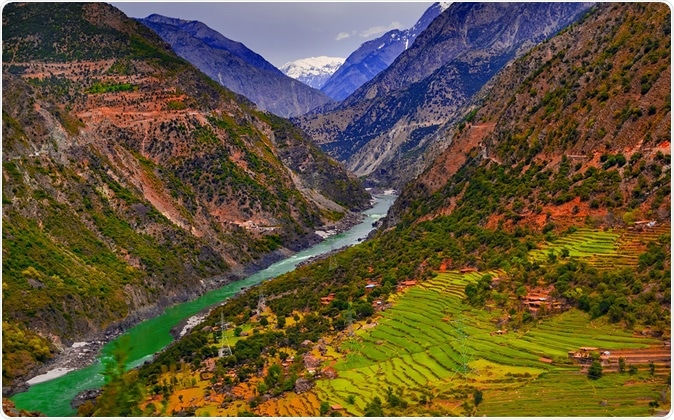Analysis of water supplies in Pakistan has shown abnormally high levels of Arsenic putting 60 million residents at risk of Arsenic poisoning. The study evaluated and analyzed around 1,200 groundwater quality samples from various parts of the country. Over the Indus plain the results show levels of Arsenic that are way above the World Health Organization (WHO) safety guidelines’ recommendations. The study was published in the journal, Science Advances.

Aerial view to Indus river and valley, Karakoram, Pakistan. Image Credit: khlongwangchao / Shutterstock
Arsenic and its risks
Arsenic is a semi-metallic element that exists in varying concentrations worldwide. It commonly seeps into the groundwater from the rocks and sediments and thus comes into the drinking water. According to the WHO, nearly 150 million people worldwide are exposed to high levels of Arsenic that comes from ground water which is contaminated with Arsenic. The permissible amount of Arsenic in drinking water is 10 micrograms per litre. Pakistan health officials set the acceptable standard of 50 micrograms per litre for their consumption.
Exposure to Arsenic and its consumption in water has been associated with a myriad of ailments including skin conditions, bladder, liver and lung cancers and also heart diseases. Exposure in children has led to neurodevelopmental delays. In 2014, the WHO estimated that nearly 200 million people globally are facing exposure to arsenic in drinking water much above the safety levels. Most of these individuals live in Bangladesh, India, Vietnam, and Nepal.
Latest study report
This new study finds that 50-60 million people who reside in the Indus valley over much of eastern Pakistan are consuming water that has Arsenic levels way above even the Pakistan government standards. For this study the team collected water samples from deep bore wells and tube wells from 1193 sites. They created a “hazard map” on the basis of their assessment of the Arsenic levels among the samples. This helped them estimate the actual population that was at risk of Arsenic exposure.
According to lead author Dr Joel Podgorski from the Swiss Federal Institute of Aquatic Science and Technology in Dübendorf, the findings of this study are “alarming”. This was the first time, he explained, that the full extent of the problem in Pakistan was mapped and quantified. He said that the whole of the Indus plain was marked in red when it comes to risk of Arsenic exposure.
The team noted that the sediments that were contributing to the high ground water levels of arsenic were relatively young. This could be the cause of such high levels. For example, an aquifer which developed since the end of the last ice age around 10,000 years ago would be younger and likely to release more arsenic compared to an older or deeper aquifer, they explain.
The situation has worsened because of the irrigation for farming. As the soil pH rises, making it more alkaline, the arsenic concentrations also tend to rise, they find. Dr Podgorski said the areas are very dry and humid and thus irrigation is also “massive” in this area. The flooding waters for irrigation tend to percolate to the aquifer, he explained. This would bring the released arsenic into the ground water.
China too is affected with ground water arsenic exposure but around twenty million people are affected In Pakistan the problem seems to be three times that of China finds the study. Although the final numbers of the affected is met with doubts among experts, most experts in this filed agree that this study has brought out an important issue for public awareness and government interventions. Dr Rick Johnston, a public health engineer from the WHO, said this study would call for a “robust water quality surveillance” on part of the health authorities to ensure arsenic-free drinking water.